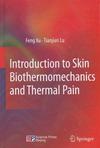皮肤热力学与皮肤热疼痛
2010-1
科学出版社
徐峰
414
无
Advances in laser, microwave and similar technologies in medicine haveled to recent developments of thermal treatments for disease and injury,involving skin tissue. In spite of the widespread use of thermal therapiesin dermatology, they do not draw upon the detailed understanding of the biothermomechanical-neurophysiological behaviour, for none exists to date,even though each behavioural facet is somewhat established and understood.In view of this dilemma, a new research area emerges, which is the subject ofthis book: "Introduction to Skin Biothermomechanics and Thermal Pain".This area is highly interdisciplinary, involving the subjects of engineering,biology and neurophysiology. This book is focused on the introduction ofthis new research area. According to the schematic relationship between theareas involved, this book is divided into four parts: PART I. Skin bioheattransfer and thermal damage; PART II. Skin biomechanics; PART III. Skinbiothermomechanics; PART IV. Skin thermal pain.
Introduction to Skin Biothermomechanics and Thermal Pain introduces the study of coupled bio-thermo-mechanical and neural behavior of skin tissue in response to thermal and mechanical loads. The research in this book focuses on the theoretical modeling and experimental investigation of heated skin tissue in order to provide a predictive framework for thermal therapies of diseased tissue in clinics. Furthermore, by developing solution tools, it focuses on changes in treatment parameters leading to more effective therapies. The book is intended for researchers and scientists in Bioengineering,Heat Transfer, Mechanics, Biology and Neurophysiology, as well as clinicians.
Chapter 1 Introduction 1.1 Introduction 1.2 Skin Biothermomechanics and Thermal Pain 1.3 Outline of the Book ReferencesChapter 2 Skin Structure and Skin Blood Flow 2.1 Introduction 2.2 Skin Structure 2.3 Skin Blood Perfnsion References PART Ⅰ SKIN BIOHEAT TRANSFERChapter 3 Skin Bioheat Transfer and Skin Thermal Damage 3.1 Introduction 3.2 Skin Bioheat Transfer 3.3 Skin Thermal Damage 3.4 Summary ReferencesChapter 4 Analysis of Skin Bioheat Transfer 4.1 Introduction 4.2 Skin Bioheat Transfer Analysis with Fourier Model 4.3 Skin Bioheat Transfer Analysis with Non-Fourier Models 4.4 Summary References PART Ⅱ SKIN BIOMECHANICSChapter 5 Skin Mechanical Behaviour 5.1 Introduction 5.2 Skin Behaviour under Stretch 5.3 Skin Behaviour under Compression 5.4 Skin Failure 5.5 Skin Friction ReferencesChapter 6 Skin Biomechanics Experiments: Measurement and Influence of Different Factors 6.1 Introduction 6.2 In Vivo Measurements 6.3 In Vitro Measurements 6.4 Influence of Different Factors 6.5 Summary ReferencesChapter 7 Skin Biomechanics Modeling 7.1 Introduction 7.2 Continuum Models and Phenomenological Models 7.3 Structural Models 7.4 Summary References PART Ⅲ SKIN BIOTHERMOMECHANICSChapter 8 Introduction of Skin Biothermomechanics 8.1 Introduction 8.2 Mechanism of Thermal Denaturation (Shrinkage) of Collagen 8.3 Properties Variations due to Thermal Denaturation of Collagen ReferencesChapter 9 Analysis of Skin Biothermomechanics 9.1 Introduction 9.2 Theoretical Analysis of Thermal Stress 9.3 Analysis with Fourier Bioheat Transfer Models 9.4 Analysis with Non-Fourier Bioheat Transfer Models 9.5 Summary 9.6 Appendix ReferencesChapter 10 Experimental Characterization of Skin Biothermomechanics 10.1 Introduction 10.2 Experimental Methodology 10.3 Thermal Denaturation of Collagen in Skin Tissue 10.4 Hydrothermal Tensile Tests 10.5 Hydrothermal Compressive Tests 10.6 Characterization of Skin Viscoelasticity with Static Tests 10.7 Summary and Limitations References PART Ⅳ SKIN THERMAL PAINChapter 11 Skin Thermal Pain Mechanism 11.1 Introduction 11.2 Definition of Pain and Pain Pathways 11.3 Anatomy and Physiology of Nociceptors 11.4 Theories of Thermal Pain ReferencesChapter 12 Physiological Features of Pain Sensation 12.1 Introduction 12.2 Role of C and Aδ Nociceptors 12.3 Influence of Stimulus Temperature on Pain 12.4 Influence of Nociceptors Depth 12.5 Influence of Temperature Change Rate on Pain 12.6 Temporal Summation 12.7 Influence of Stimulus Duration 12.8 Spatial Summation 12.9 Hyperalgesia and Tissue Damage 12.10 Influence of Origin of Skin (Different Part in Body) 12.11 Influence of Skin Type 12.12 Gender Difference 12.13 Influence of Age 12.14 Summary ReferencesChapter 13 Skin Thermal Pain Modeling 13.1 Introduction 13.2 Model of Transduction 13.3 Model of Transmission 13.4 Model of Modulation and Perception 13.5 Results and Discussion 13.6 Summary References
However, classical grips which apply a pressure on the sample ends lead toa slippage of the sample if the pressure is too low, or damage of the samplenear the grips if the pressure is too high[147]. Gluing the samples to thegrip can be successfully done for very thin samples. However, if samples aretoo thick there is shear between the fixed sample sides and the sample core,giving a complex pattern of strain in this region[159] and the inner fibers of thesample are less strained than the fibers at the surface. Despite the reducedslippage or failure of connective tissue at the clamping site, a non-uniformloading pattern may occur, with uneven fiber recruitment of the tissue undertension and the constraint on the extracellular fibers at the bounds ofthe sample is induced[149], which will result in low measurement precisionand non-repeatability[146].SutureDue to the drawbacks of clamping described above, many researches haveused suture[161], where a specimen is attached to loading assemblies by severalcontinuous loops of medical suture per edge since using thin threads allowsthe free expanding of sample edges in the lateral direction[13], as shown inFigure 6.3. However, suturing sample edges might result in a discontinuousload transfer to the underlying fibrous network since only discrete groups offibers within the vicinity of the suture attachment point are loaded[149].Waldman & Lee[149] compared the dynamic biaxial mechanical responseof soft biological tissue samples under suturing and clamping under the sameconditions. It was found that the tissue samples appeared to be stiffer and lessextensible when mechanically tested with clamped sample edges, as opposedto when tested with sutured sample edges; and suture attachment methodsdemonstrated minimal boundary effects where four suture attachments aresufficien~ to obtain uniform stress field in biaxial testing. The same resultshave also been obtained by Sun et al.[140]1, who found that there were strongboundary effects with the clamped methods, which resulted in the fact thatthe inner region was not fully loaded and therefore not fully stretched andmakes the tissue appear to be substantially stiffer.
《皮肤热力学与皮肤热疼痛(英文版)》由科学出版社出版。

无
不错的专业书籍~适合用于学术研究,价格偏贵了一些哈~